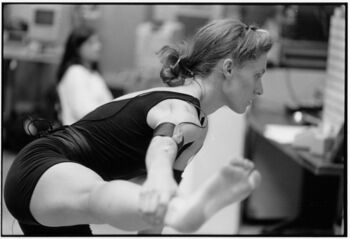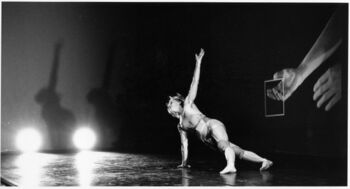Experimental performance-makers in the late 20th century responded to the advent of new media (television, video, computers, the internet) with many innovations in how they made performances, and by making work about the impact of those technologies.
In the 1960s and 1970s – decades of great artistic, social and political upheaval and change – telecommunications and media technology were rapidly advancing. Television, video and early computer equipment became more accessible, creating a climate for artists to turn this ‘dead’ technology and data into something living, and to address the impact of these new technologies, both freeing and overwhelming.
Between 1975 and 1977 artists Kit Galloway and Sherrie Rabinowitz created a series of projects under the heading Aesthetic Research in Telecommunications, seeking to investigate how the new technologies could be used to create telecollaborative arts. A Space with No Geographical Boundaries embodied this new age of satellite telecommunications by allowing several performing artists from different geographical locations to perform, communicate and to appear as though they were occupying the same physical space. The artists explored the transmission delays over long distance networks, and performed several telecollaborative dance, music, and performance scores to determine what traditional genres could be supported, while exploring new genres intrinsic to these new ways of being-in-the-world. It was thought that by integrating multiple-media telecollaborative technologies with the culturally diverse creative communities throughout Los Angeles, a powerful new context for cultural sharing would emerge to facilitate a creative conversation between people even if they didn’t speak the same language.
The Wooster Group’s 1984 production LSD…Just the High Points, based on Arthur Miller’s The Crucible, placed multiple television screens on the stage, displaying pre-recorded video sequences and live feeds from cameras on stage, giving close-up images of the actors, showing point-of-view walking, and so on. Sections of the text of The Crucible were skipped by ‘rewinding’ and ‘fast-forwarding’ on the screens, and dialogue could take place between an actor on stage and an actor on screen. LSD…Just the High Points was innovative in many ways, but perhaps most crucially it established that media images on stage could be fully integrated into the dramaturgy, rather than being something contextual as a background or environment.
Troika Ranch is a dance/theatre/media (the troika) company founded by Dawn Stoppiello and Mark Coniglio. They aim to produce work that values live interaction between viewer and viewed, performer and image, movement and sound, people and technology. The works may be presented as performances, installations, or in portable formats, drawing on contemporary technologies and innovations. Like Galloway and Rabinowitz, they have created networked performances utilised online networks to deliver a performance from a distance, known as ‘telepresence’. Their 1990 production Tactile Diaries explored the ways we touch one another: emotionally, physically and virtually. The piece was performed simultaneously at The Electronic Cafe in Los Angeles and The NYU Television Studios, New York City, with images gradually transmitted over ordinary phone lines between each location. In 1996, only 5 years after the world wide web was made available to the public, Troika Ranch created Yearbody, a year-long dance piece in which an image of a dancer was posted to a website each day, and then made into an animation of the dance at the end of the year.
Troika Ranch developed MidiDancer in 1989: a system with eight flex sensors fitted on the elbow, wrist, hip and knee of a dancer, which send data wirelessly to a computer about the flexion and extension of the dancer’s joints. This data was used in various performances, including In Plane, a duet for a dancer and her video image representation. MidiDancer allowed the performer to control the generation of music, the recall of video images, the theatrical lighting, and the movements of a robotically controlled video projector. Coniglio also created the software Isadora (Q30634) to make incorporating digital technologies and multimedia into performances easily accessible to other artists; the software is now widely used by performance-makers who want to use rich media and interaction in their work. The creation of custom-designed technologies is a characteristic feature not just of Troika Ranch, but of many experimental and avant garde performance arts groups, especially in the field of dance. As well as meeting the specific needs that may not be addressed by commercial products, many artists see the creation of the technologies they use as an integral part of the creative process – their work is often about the technology, our relationship with it, and its social, cultural and political impact.
For the last decades of the 20th century, with the growing availability and potential of various kinds of media technology, performance-makers have experimented in a wide variety of ways with the use of media on stage. The performing arts became a mode of investigating the possibilities and limitations of various technologies to create new contexts for art, including: the emergence of telecollaborative arts reaching across cities, countries and continents; the use of sensors to capture the movement of performers and integrate them into a hybrid human-technology performance system; presenting performances on the web in unexpected ways; and combining visual media with live stage action as part of a holistic dramaturgy. These, and many other innovations were creative strategies for embracing apparently ‘dead’ media technology, making it into a rich hybrid with the established live performance forms of theatre, dance, and music: a breathing expression of life which can now be seen as an accepted element of mainstream performances in the 21st century.

